Ecommerce Development: Turning Ideas into Conversions
Author :
- What is Ecommerce Development?
- The Importance of Ecommerce Development
- The Process of Ecommerce Development
- Main Features of Ecommerce Development
- Ecommerce Website Development Cost
- Ecommerce Growth Marketing Strategies
- Use of Artificial Intelligence in Ecommerce
- Future Ecommerce Trends
- Common Ecommerce Development Mistakes to Avoid
- How an Ecommerce Development Agency Helps
Today, we are living in a world where everything is digitalized. Now, going to the shop means clicking a button rather than walking into it.
You may be purchasing sneakers, groceries, or gadgets but you are most likely to be purchasing them online. It is this magic of purchase and selling via internet that we refer to as ecommerce development.
However, here is the catch. Having a successful online store is no longer about an online presence. You can’t just have a website displaying few of your product. Now, it is a matter of strategy.
A strategy in design, technology to develop an experience that customers adore. This ecommerce developer reference guide talks about how ecommerce web development works, why it is important, and how you can develop your own successful online business.
What is Ecommerce Development?
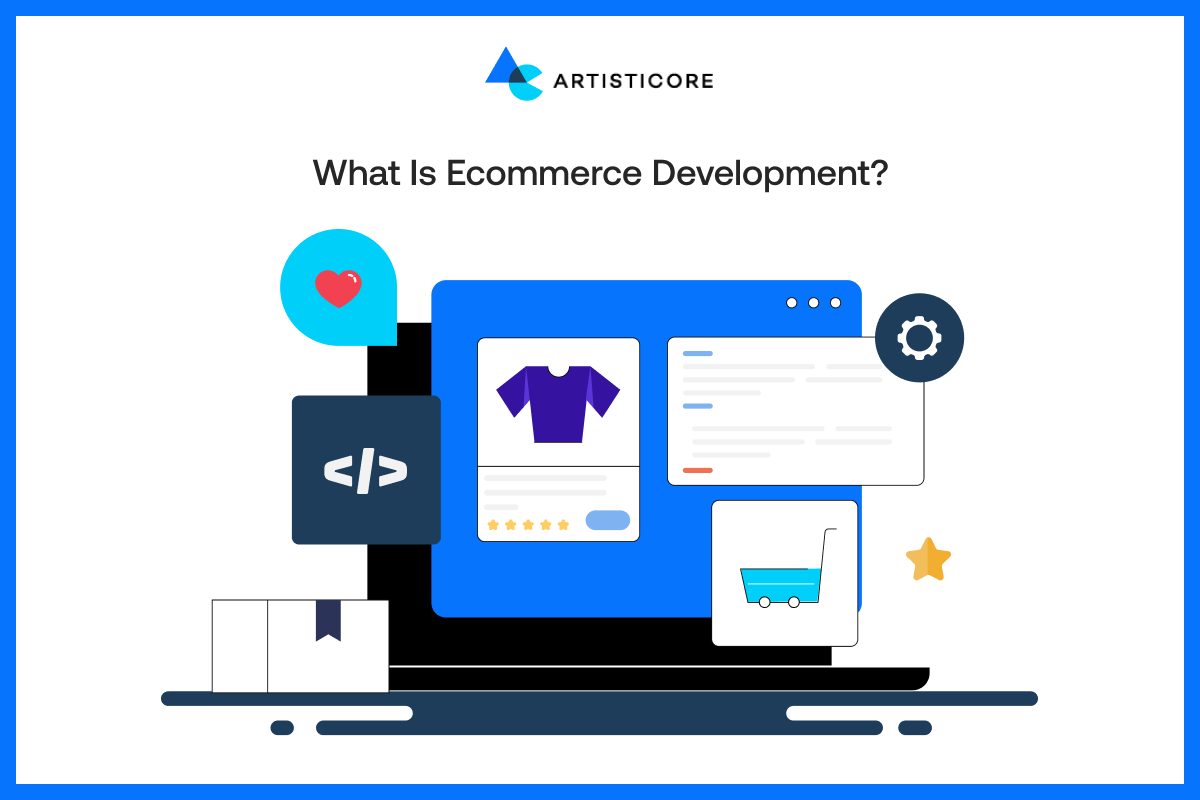
In simple terms, ecommerce development can be defined as the design, development and maintenance of an online store. A store where companies can sell their services and products.
Imagine it as constructing a virtual store. You will require shelf which means product pages, cashier means payment gateways, fitting room means product demos, AR, or size guides and, last but not least, attentive employees basically through customer support tools.
Any effective ecommerce site needs proper planning, intelligent design, and technology. Doesn’t matter if you are starting a business or growing an existing retail company, you need ecommerce development. This is what will help you sell and grow digitally.
According to Shopify, the world e-commerce sales are projected to reach 6.42 trillion in 2025. Though ecommerce sales growth will decrease by a slight margin in 2025, it will recover to 2026, with a growth of 6.88 trillion. It will rise by 7.2 percent in 2027 and contribute to 7.38 trillion sales and rise by 7.89 trillion in 2028.
The Importance of Ecommerce Development
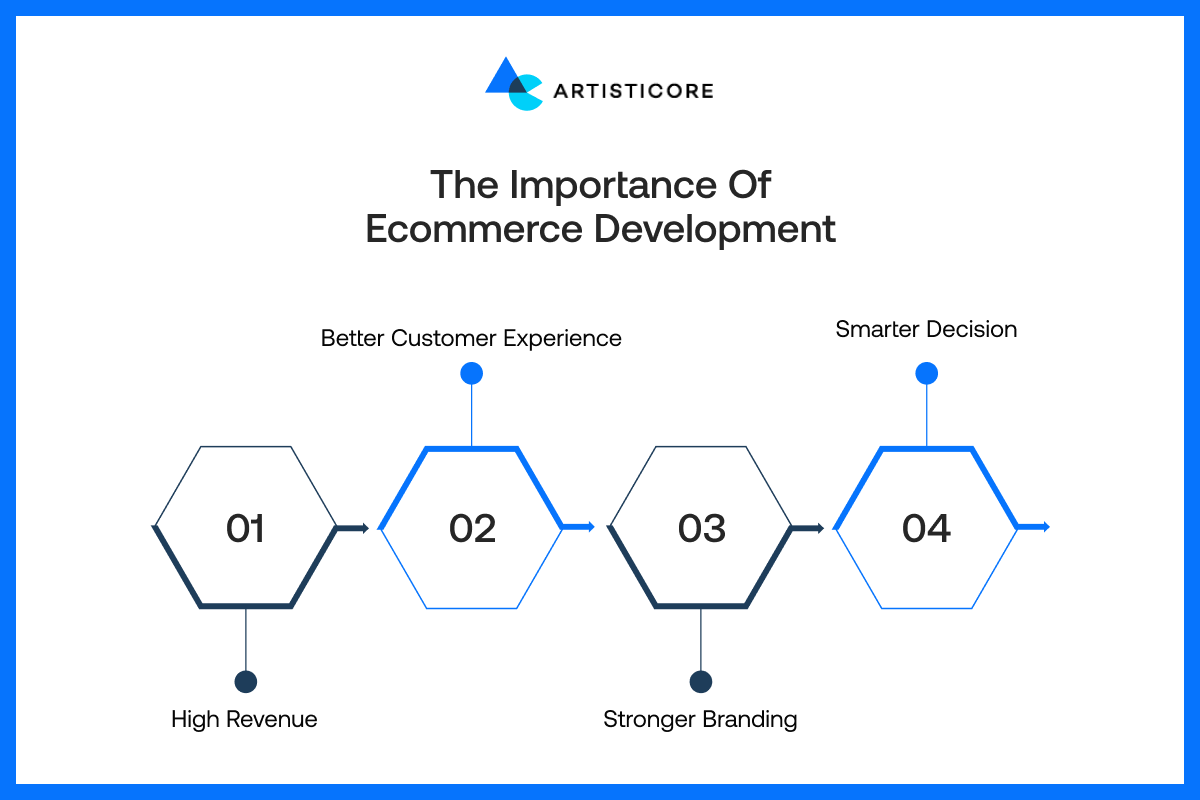
When you enter a physical store, you instantly have an impression based on what it looks like. You look at the way staff treat you and how easy it is to get what you want.
The same happens online. So, the choice is yours, whether you focus on developing a well-structured or a cluttered designed website.
Ecommerce development is much more than just uploading a few products. It is about how to create the smooth experience that helps to create trust. And yes, it will increase the sales, and build your brand identity.
High Revenue
Unlike any physical stores that closes at 12 am at night, ecommerce stores operate all day and night. It has a store open on every time zone and is ready to serve customers 24 hours a day. The result of that constant access is an increase in the potential sales.
According to Stape, companies that have optimized ecommerce development and search experience enjoy up to 30% more conversions than the rest.
As mentioned above, maximum number of brand impressions are design related. So, a user-friendly and refined design can help customers put more money in your pocket.
Better Customer Experience
Consider your shopping habits. Would you go back to a shop where you cannot check out because making payments is a puzzle? Probably not.
Effective ecommerce development process can guarantee quick loading pages, easy navigation, secure payments, and easy checkout.
A satisfied customer will not only come back but also recommend to his friends. That is the way to develop loyalty in the digital world.
Stronger Branding
Your web site is your virtual front office. Mostly, it is your front line of contact with your customer.
An effective ecommerce portal development platform ensures that your brand appears and feels the same. No matter how one gets to you on Google, Instagram, or via a referral.
Your site speaks volumes about you. Not only because of your logo design or color palette but because of how you describe your products.
Remember, good branding builds trust and trust builds buyers.
Smarter Decisions
Here is what offline stores cannot always do. They can’t follow each click, scroll and purchase step-by-step.
Ecommerce provides instant customer behavior data. For example, what they like, where they lose interest, products they show references but do not purchase.
With this information, you can adjust prices, enhance product descriptions and optimize marketing campaigns.
Want Stunning ecommerce website? Let Artisticore Create Custom Ecommerce website
The Process of Ecommerce Development
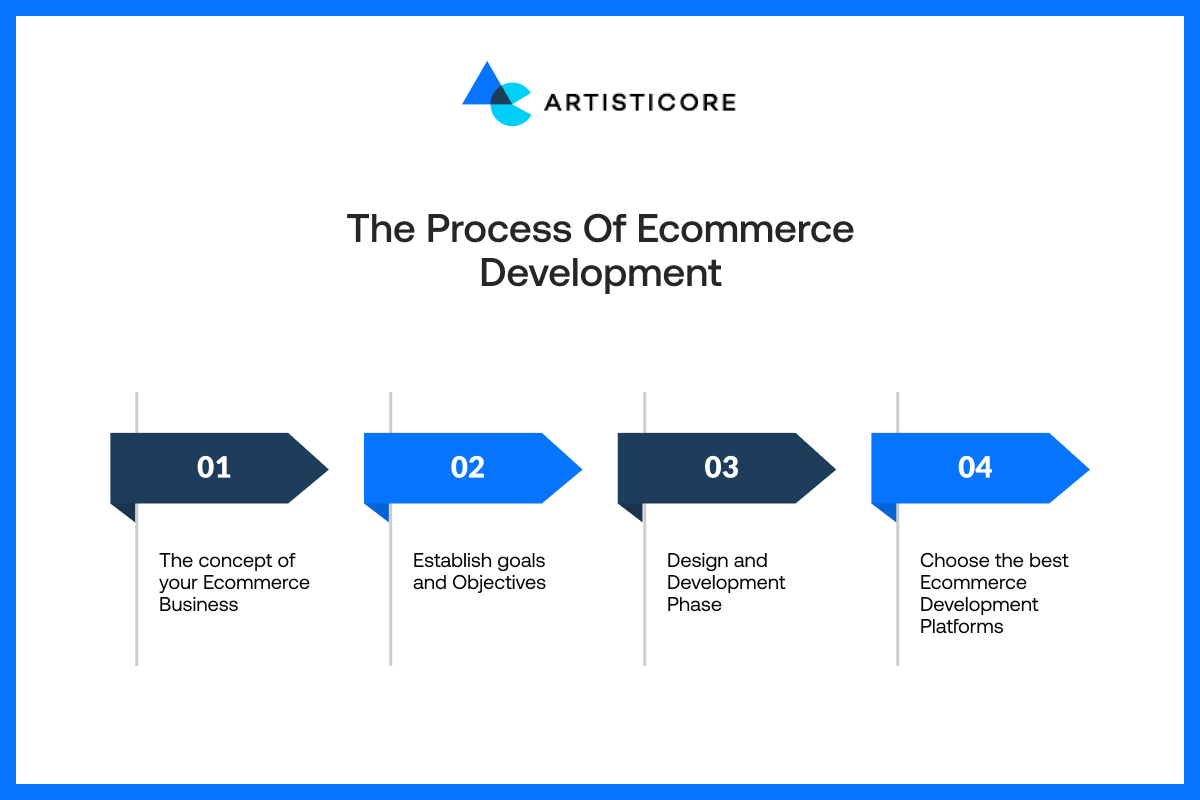
Creating an online store is just like constructing a house. You can’t just start piling bricks without a plan. Similarly, a successful ecommerce web development needs proper planning.
It needs firm foundation and intelligent finishing touches. If done right, it can give you both beautiful and functional results.
The Concept of Your Ecommerce Business
Any winning brand begins with a vision. You must be clear before you consider design or coding. Who are you selling to? What is your market gap? Why should others prefer your product over others?
This is a stage where extensive market research and competitor study is done. In case you are planning to sell eco-friendly apparel, such as Patagonia or Everlane, research them. What do they do well? Where do customers complain? Use it to form your own value proposition.
Not only a clear concept helps to sharpen your business direction but also everything else. For example, your brand voice, your web-design, your marketing campaigns.
Without this clarity, your online store will simply be another online shop that will be lost in the sea.
Establishing Goals and Objectives
After you have a clear picture of what you want, now you need to draw a roadmap on where you are heading. It is like laying your ecommerce development project map on the GPS.
Rather than general objectives such as I want more sales, be specific. For say, make a goal to make 30K sales in a year or have 1K new email subscribes in the next 6 months. And yes, what you can do is you can also cut the rate of shopping cart abandonment by a 1/3 over three months.
See, these are called SMART goals. S for specific, M for measurable, A for achievable, R for relevant and T for time bound.
Real-Life Example
A new small skincare company was launched with the purpose to reach 500 orders within three months.
They employed the strategy of influencer marketing, targeted advertising, and having a convenient online store.
They were doing everything calculatedly. Why? Because they had clear goals that they needed to attain. They knew what to monitor and where to make changes. In 2 months, they achieved their target.
Remember, it is easy to waste money and time without goals in place. Your roadmap is clear with them.
Choosing the Best Ecommerce Development Platforms
Your online store is based on your platform. It is not only where your site is hosted but about degree of flexibility, scalability of your shop. Basically, the ease with which your customers can browse.
Selecting the right platform is important because it can either succeed or fail your business.
Shopify
This is the first option of small to medium businesses and beginners. It is full-service, which means you do not have to worry about hosting, payment gateways, or security.
With its ease and robust app ecosystem, Shopify services more than 4.8 million online stores across the world.
WooCommerce (WordPress)
Ideal when you have a WordPress site or wish to have complete control. It is open-source, which means limitless customization.
Have a large product catalog? Want unique store features? WooCommerce is flexible.
Wix
It provides a drag-and-drop builder making it the Lego of the ecommerce business. You do not need to write code in order to create beautiful stores. Wix is perfect for small companies seeking fashion and ease.
Squarespace
It has beautiful and artistic templates that work well for artistic minds. Mostly youth go for this platform. Moreover, if you run a business that requires too many visuals. For example, fashion photography, graphic or digital design store then this is for you.
Custom Ecommerce Web Development
In case you want to remain unique among the competitors or want an Amazon-style marketplaces. Then, a custom built solution should be your approach. Artisticore provides scalability, speed, and personalization. Sure, it is costlier, but it is also future proof.
Tired of Dull Web Design? We Create Custom Web Designs that Make You Stand Out.
Design & Development Phase
The design and development are at the stage where creativity is combined with functionality. It is not a matter of ensuring that your ecommerce store is beautiful. But it is about making sure that your site is efficient and safe. Moreover, it is about making your clients hooked at you from beginning to the end.
Just imagine creating a store where all shelves are accessible, all aisles are well marked. And on top, the checkout counter is painless to operate.
Interactive Ecommerce Design
Modern consumers transition freely across different devices. They are using multiple screens at a time. This means that your online shop needs to fit flawlessly everywhere. Responsive design always results in zero frustration and cart abandonment.
Effortless Navigation
The customer must be capable of locating what they need within several seconds. Search bars, filters, and category menus allow intuitive navigation, making browsing a pleasant experience.
For example, Amazon is not only famous due to its large product range, but because of its navigation. Their navigation is extremely fast and responsive to user behavior.
Checkout / Shopping Cart Experience
There is no quicker way to lose a sale than by a lazy checkout procedure. Painful right? But you must have experience it too. It does not only frustrate you but also make you question your security.
Ecommerce development works by reducing heaps of stages like guest checkout, autofill functionality and displayed shipping expenses. And the results? Increase conversions.
According to Shopify and other credible sources, Amazon was the first that offered one-click checkout in 1999, which has then become a game changing feature.
Safe Payment Gateways
Nowadays, consumer demands selection. By providing credit/debit cards, PayPal, digital wallets, and even cryptocurrency, you will never lose a customer.
Lack of different payment methods cause loss of sales. To minimize this, use integrated-payment gateways that will generate trust in your store.
Security That Builds Trust
Ecommerce is built on trust. Fraud detection tools, encrypted transactions and the use of SSL certificates safeguard your business and your customers.
When buyers are sure that their information is secure, they are more likely to return.
Main Features of Ecommerce Development
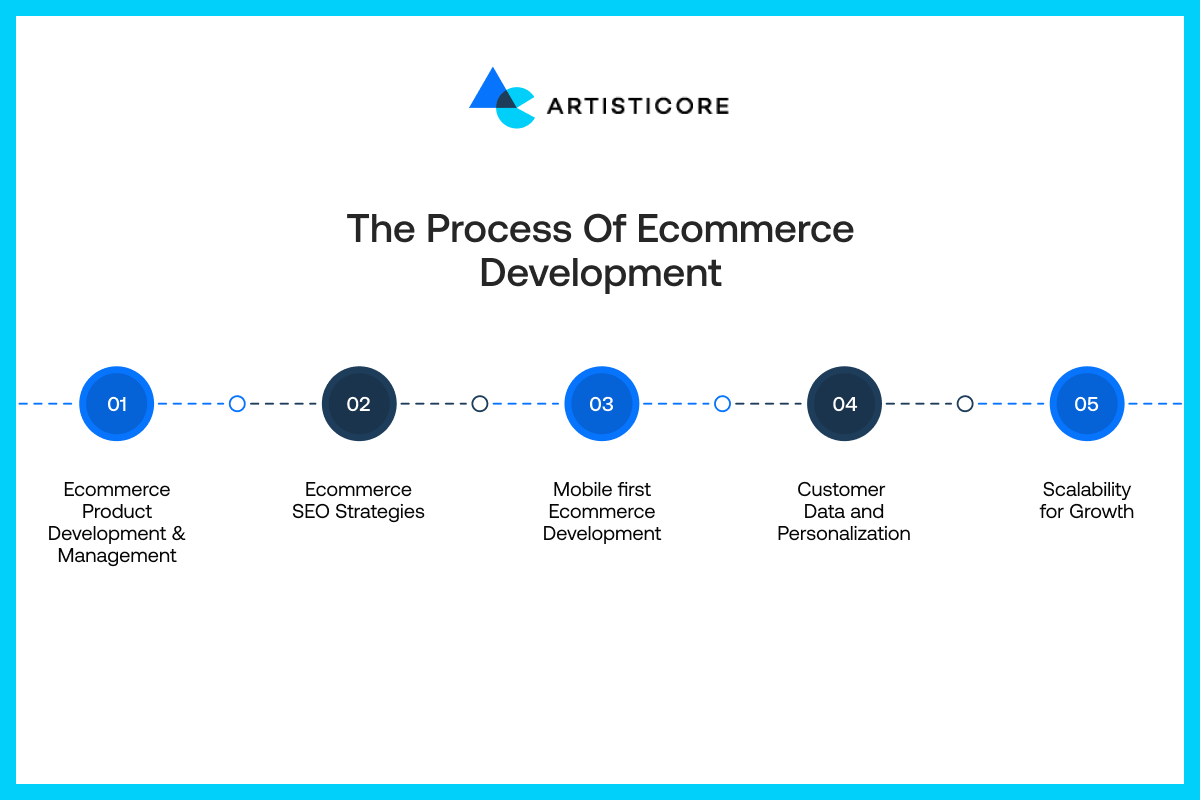
Any ecommerce site should be well grounded in features that balance between customer requirements and business expansion. These are not merely nice to have, they are the key components of your online shop that are effective, scalable and profitable.
Ecommerce Product Development and Management
Before designing and developing, you need to have a product list in your mind. What are you going to sell? What is your product?
See, when you develop an ecommerce store, you are required to have a product list. That product needs to be well-designed.
You can use optimized the product list using detailed description, adding quality images, animations, and formed categories.
Furthermore, you can also add reviews because reviews and feedbacks earn trust and confidence.
The shopping is also improved with features such as zoomable images, comparison tools, and stock updates.
Ecommerce SEO Strategies
Even the most well-designed store can’t make sales without visibility. Which is why optimization is required.
Ecommerce SEO involves optimization of product names, descriptions, metadata and URLs to use the relevant keywords.
Adding blogs, guides, and buyer resources, as you can get on the first page, attracting organic traffic and gaining authority.
Mobile First Ecommerce Development
Mobile-first design is not negotiable since mobile commerce now contributes more than 70% of all sales in the world.
To minimize bounce rates, ecommerce developers focus on loading mobile pages quickly, navigation that can be touched on with thumb, and mobile checkout.
Sites that are mobile-optimized are also ranked higher by Google.
Customer Data & Personalization
Modern ecommerce development solutions are not just about simple transactions. Customer accounts, wish lists, order history, and personalized recommendations are some of the features that enable businesses to build loyalty.
Customers are more likely to come back when they feel that they have been heard.
Scalability for Growth
A little store now might become an international brand tomorrow. Scalable ecommerce web development will make sure your site can accommodate traffic, product lines, and sales expansions without collapsing. Cloud hosting, pluggable modules and bespoke integrations scale your business to grow.
Ecommerce Website Development Cost
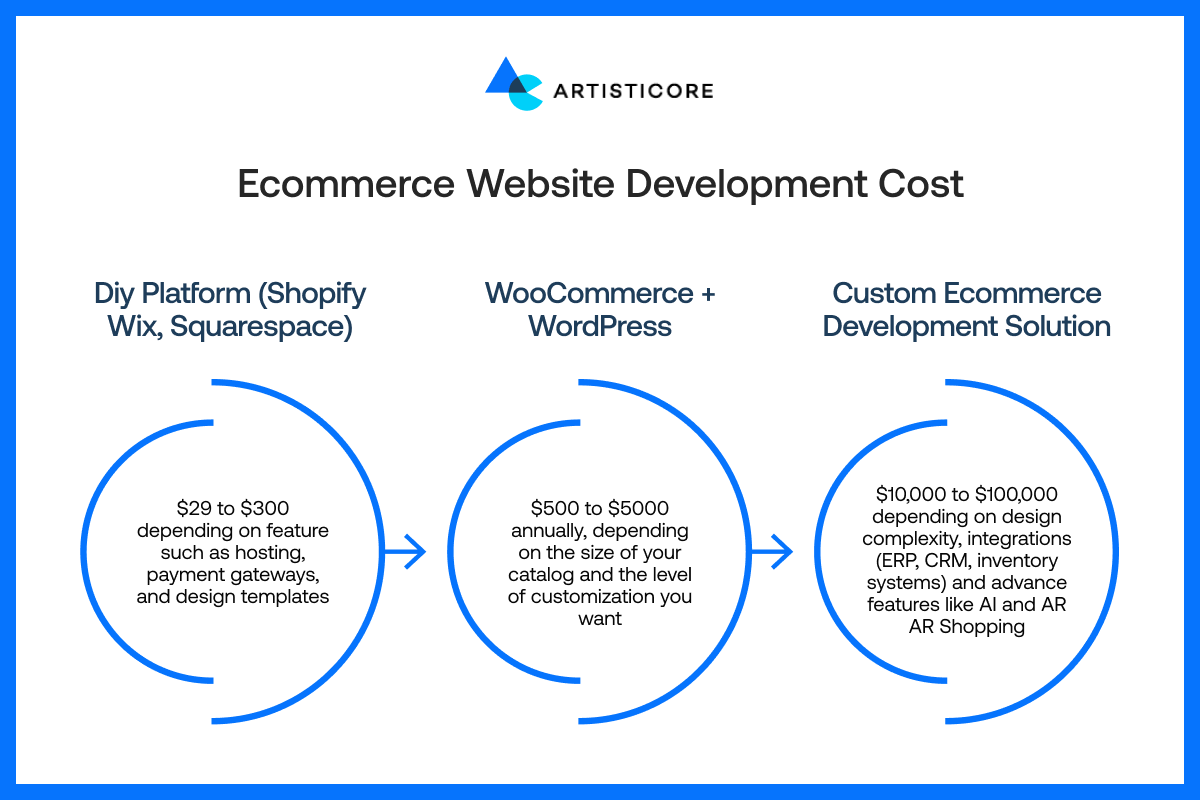
The most common question is about the cost of developing an ecommerce site?? Well, it differs according to your business size, goals and the level of customization.
Just like a brick and mortar store, your online budget will rely on the some of the important factors. Now what are those? Those include design, technology, and your store location in the cyber space.
The cost depends whether you opt for self service solutions or connect to an agency.
DIY Platforms (Shopify, Wix, Squarespace)
There are DIY Self-Service Solutions (Shopify, Wix, Squarespace). These are affordable and anyone who is stepping into ecommerce can use these.
The monthly plans cost between $29 and $300 depending on features. They offer hosting, payment gateways and web design templates for small businesses who need speed and simplicity.
WooCommerce + WordPress
WooCommerce is also free. However, there are hosting, theme, and premium extension charges. If you go premium, they will charge you from 500 to 5k USD per year and too depends on the level of customization.
Now, considering the amount, these premium features work best for established companies. If you are just starting, then go for a free one.
Custom Ecommerce Development Solutions
Custom ecommerce web development offers the highest level of control to unique business models. The high investment may look like a burden but every penny is worth it because you can better rewards.
Research a bit on your own like look for the designs and the kind of features you want to add. The amount you pay depends on these factors. For example, whether you want AI personalization or other inventory systems or not. Do you or you don’t want ERP and CRM?
These are the few things you must know in order to make the best investment and achieve your long term objectives.
A Scenario
Suppose you want to open a boutique. Now the site, the size, the interior design and staff are the key elements that will influence your budget. Ecommerce works the same way.
The amount you spend depends on your aspirations, whether you are using a DIY platform or a tailor-built store. A professional agency like artisticore can provide with a whole ecommerce website development project plan for you to make a wisest investment.
Ecommerce Growth Marketing Strategies
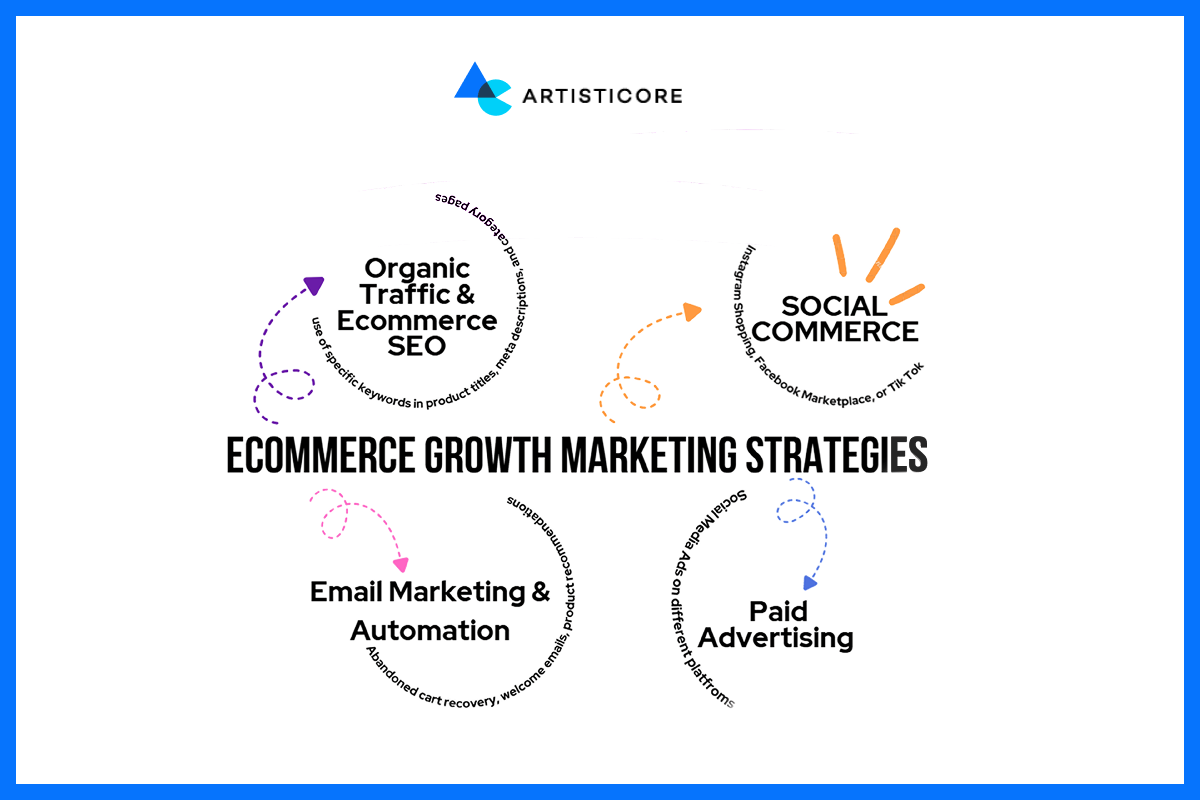
Setting up your ecommerce is just the start. In order to transform the browsers into buyers, you must have a good marketing strategy. A perfect strategy is what will generate traffic and conversions.
Ecommerce web development and marketing go together. It’s like you are the audience, your store is your stage, and marketing is what you supply to the audience.
Organic Traffic & Ecommerce SEO
One of the most effective long-term ecommerce strategies is search engine optimization. This is done by the use of specific keywords in product titles, meta descriptions, and category pages.
Optimization help customers and viewers discover your store on Google. For example, with optimization, if you rank number 1 as sustainable women clothing, Google will automatically get you 1000s of visitors monthly without having to pay for ads.
Paid Advertising
Google Ads, Facebook, and Instagram are advertising platforms that are able to target particular audiences. Retargeting ads increase the probability of purchases.
Here you display advertisements to individuals who have been to your store but purchased nothing.
Now, these Ads will help convert window shoppers to customers.
Email Marketing & Automation
The use of emails is still a secret weapon in ecommerce marketing.
Email automation builds customer relationships. Wonder how? Basically, it works by welcoming visitors to reminding them about cart abandonment.
HubSpot, marketers report 59% of their ROI comes through email, and those who used segmented campaigns report up to 760% more revenue.
Social Commerce
Social media is no longer an interaction tool. It is a direct sales tool.
By connecting your ecommerce portal to Instagram Shopping, Facebook Marketplace, or Tik Tok Shop, you can make customers find and purchase your products immediately.
Use of Artificial Intelligence in Ecommerce
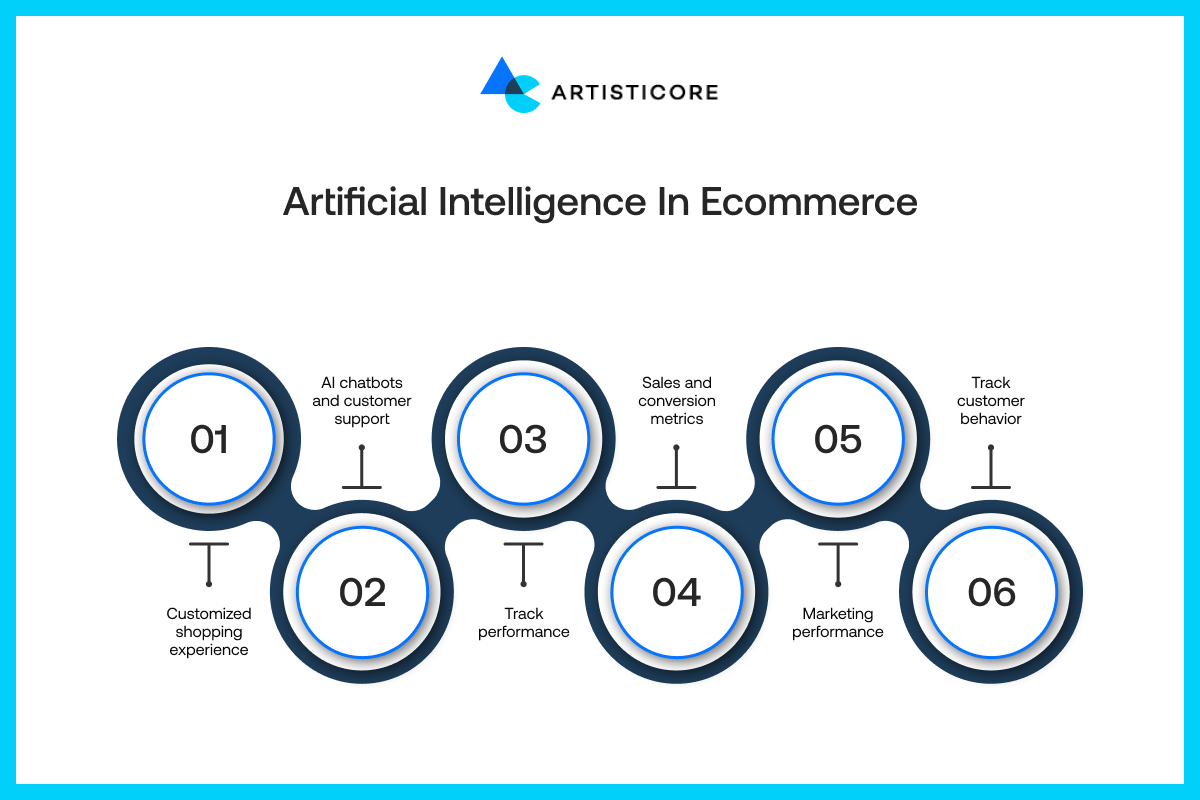
In the digital era, personalization is no more of an option, but a requirement.
Customers desire brands to be able to learn their tastes and serve them without being annoying. Personalization and AI-based ecommerce development come in there.
Customized Shopping Experiences
Ecommerce websites are able to monitor history, purchase and even the abandoned cart and provide customized experiences.
Recommendation of “You may also like” or personalized discounts such as “40% OFF” lead to higher chances of conversion.
Amazon makes more than 35% of its revenue through product recommendations.
AI Chatbots and Customer Support
Artificial Intelligence chatbots are transforming ecommerce customer care.
They are accessible 24/7 and respond to questions, suggest products, and take customers through the check-out.
This helps lower the operational costs and buyers receive instant support.
Predictive Analytics
Advanced ecommerce development incorporates AI that forecast shopping preferences.
AI is able to predict demand by examining customer behavior, allowing businesses to adjust inventory and pricing strategies.
This is a proactive strategy that minimizes overstocking and lost sales.
Track Performances
You cannot improve yourself unless you are aware of what you are doing. The data of the online shops transforms simple numbers into useful information and allows the businesses to make smart decisions.
Track Customer Behavior
Ecommerce analytics tools can show the traffic of your customers through heatmaps, click-through, and more.
Observe! Do they leave carts at the checkout? Do they go to product pages but fail to make a purchase? There are the areas of improvement that can refine support your goal.
Sales & Conversion Metrics
It is important to track key numbers such as conversion rate, average order value and customer lifetime value.
Nowadays, online shops apply AI to predict purchases by buyers. The AI tools examine how customers behave in order to know the demand.
Knowing the demand of a product help companies modify the stock and their prices to save themselves from excess stock or lost sales.
Marketing Performance
Analytics would also inform which marketing outlets produce the highest ROI.
When Instagram ads perform better than Google Ads, you are able to spend more money to maximize returns.
Ecommerce development solutions can blend with tools such as Google Analytics, HubSpot, or Shopify analytics to make data-driven decisions.
Future Ecommerce Trends
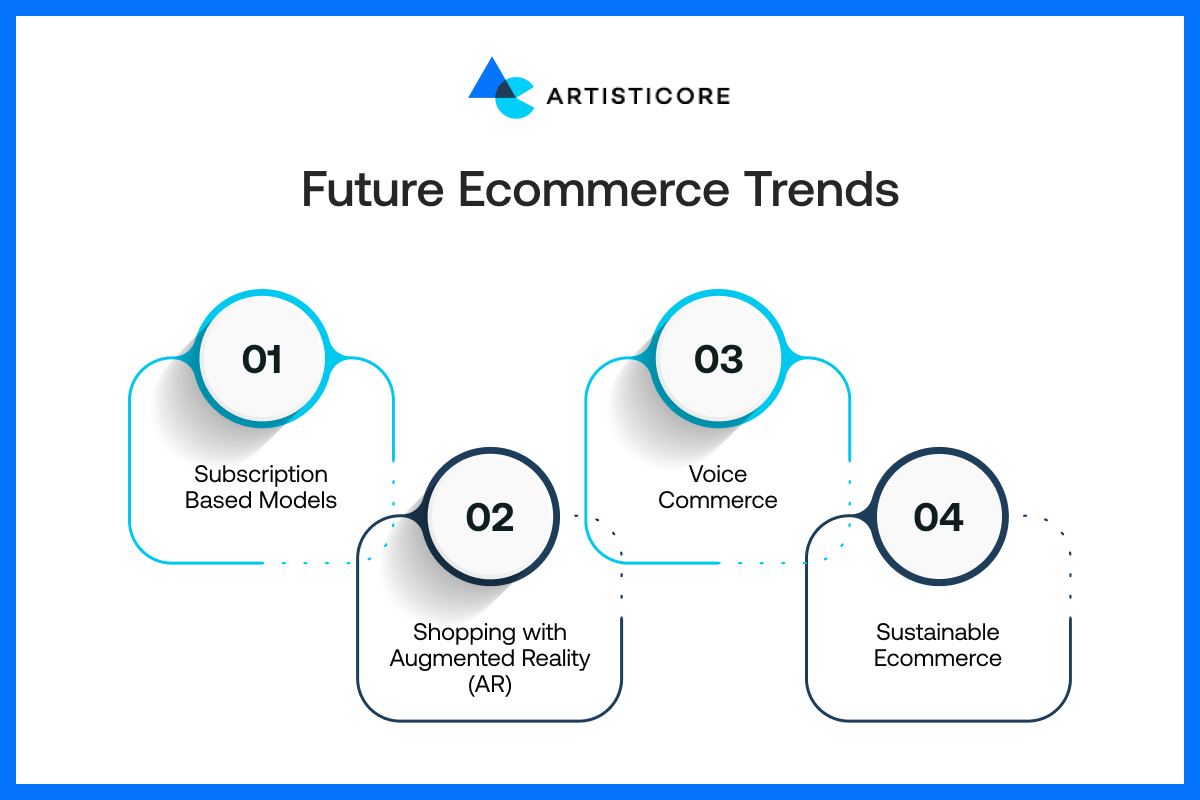
Ecommerce is ever changing. Companies must be in a position to identify new trends and respond to them in order to remain competitive.
Voice Commerce
Voice-based shopping is increasing nowadays. Brands are using voice assistants such as Alexa and Google Assistant.
If you want to be a leading ecommerce company in the future, optimize your product listings to voice search.
Shopping with Augmented Reality (AR).
AR enables customers to see the products in their space before making a purchase.
Furniture companies such as IKEA make use of AR that allow customers to visualize how a sofa will fit in their living room. This help customers make informed decisions.
Sustainable Ecommerce
Today’s customers are more concerned of the environment. It is important for ecommerce stores to now go for carbon-neutral shipping, recycled packaging, and eco-label filters.
Two things will happen; you will save the environment from any damage and also attract environmentally aware shoppers.
Subscription Based Models
Subscription ecommerce is on the rise, whether it is beauty boxes or meal kits.
Tailored ecommerce web development can incur recurring payment structures, customer portals, and loyalty programs to facilitate a subscription business.
Common Ecommerce Development Mistakes to Avoid
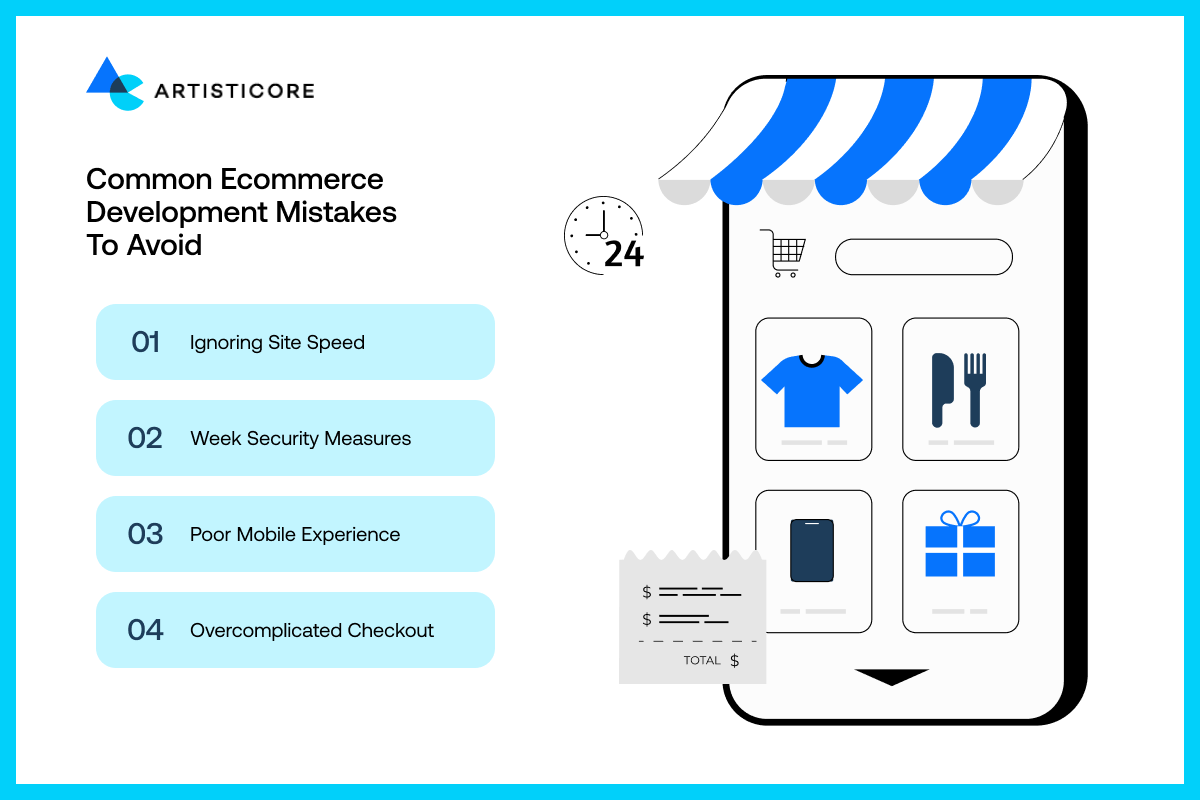
Poor decision making in the process of ecommerce developments may undermine success. Even if you have the best product listing, a solid plan is still what you need.
The following are some of the mistakes that businesses should avoid.
Ignoring Site Speed
A slow loading website is simply a money killer. Studies indicate that half of the mobile phone users will abandon a site if it is taking them more than 3 seconds to load . It is essential to maximize performance.
Weak Security Measures
A data breach is the quickest way to kill customer trust. Always use the use of SSL certificates, two factor authentication and payment gateways that are compliant with PCI.
Poor Mobile Experience
Most sales occur over mobile. If you do not work on all screen optimization, you will face a huge customer base loss.
Overcomplicated Checkout
Any added step during checkout adds means high chances of cart abandonment. Having a straightforward, open, and safe checkout process is important to achieve maximum conversions.
How an Ecommerce Development Agency Helps
A good ecommerce development agency is your shortcut to success. These are the following things that they you with:
Strategy
You do not have to spend time on trial and error. They have a team of experts who know how to build a sellable store
Custom Ecommerce Development Solutions
They design tailor-made solutions to your business model, be it a simple setup or sophisticated features.
Time and Cost Efficiency
In the long term, agencies can save you a substantial amount of money. They create for you scalable and reliable platforms that will save you from expensive repairs in the future.
Continued Maintenance and Service
They also provide you with round the clock assistance. Also, they make sure your store is secure, works fast and convert visitors into customers.
Need Help Making Your Ecommerce Store? Work with Our Experts to Get the Best
Conclusion
Ecommerce development is not about creating a website but about building an online shopping experience. It is very important to have a proper strategy that is solid before you get into development stage. Ecommerce development is based on trust, loyalty and purchases. Your goal is to build something that you would like for yourself and where you would go to shop. Every single step count.
Beginning with the thought of owning an ecommerce business, choosing the appropriate platform, developing UX/UI design, integration of payment gateways, influencing SEO, and lastly keeping up with the trends to be unique. Whether you do it little with Shopify or you invest in custom ecommerce solutions, strategy, execution, and customer experience are keys to the success.
Look, the world is making purchases via the internet. You and I, we all are doing it. Your company needs to do the same. This blog serve works as the right ecommerce website development tutorial that will help you to turn an idea into a profitable online store.
